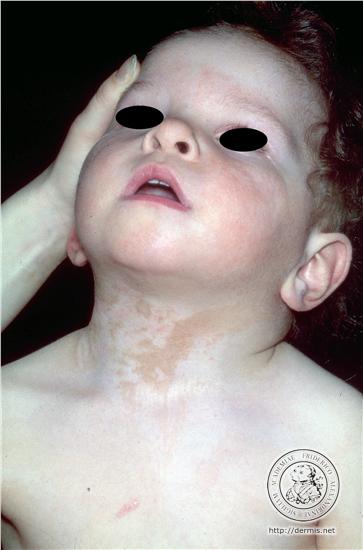What Are Birthmarks?
 Birthmarks are areas of flat or raised discolored skin that are often seen on the body at birth or may develop shortly after birth. Some may even be indistinct at birth and may only become visible in adolescence. They vary in colour and may be brown, tan, or black to blue, pink or red. Some birthmarks are only stains on the surface of the skin, while others extend into the tissues under the skin or grow above the surface.
Birthmarks are areas of flat or raised discolored skin that are often seen on the body at birth or may develop shortly after birth. Some may even be indistinct at birth and may only become visible in adolescence. They vary in colour and may be brown, tan, or black to blue, pink or red. Some birthmarks are only stains on the surface of the skin, while others extend into the tissues under the skin or grow above the surface.
What Causes Birthmarks?
Most birthmarks are not inherited and are not caused by anything that happens to the mother during pregnancy, but the exact causes of birthmarks are unknown.
Are Birthmarks Harmful?
Most birthmarks are often harmless. Sometimes birthmarks may be located in critical areas like around the eye where it may cause obstruction. Some very rare types of birthmarks may also be associated with serious underlying internal abnormalities or may be pre-cancerous.
What Are The Most Common Types Of Birthmarks?
The commonest birthmarks can be either pigmented or vascular.
What Are Pigmented Birthmarks?
Congenital Naevi are typically present at birth, brown or black in color, vary in size and location and can be either raised or flat. These common birthmarks most often require no treatment. However, naevi with irregular color or borders, a nodular surface or bleeding should be evaluated by a dermatologist. Large naevi, particularly on the midline of the back or scalp, should also be evaluated. Surgical removal may be necessary for atypical appearing naevi due to a potential risk of skin cancer.
Café-au-lait spots are tan or light brown patches that are the result of too much pigment in the skin. These discolorations can sometimes appear in multiples, and about 10-20 percent of children and adults have one. Café-au-lait spots may fade over a lifetime, but do not usually go away. A single spot is not typically serious, but numerous spots may suggest other health problems and a dermatologist should be consulted.
Mongolian spots are flat, gray-blue discolorations found on the back or buttocks of babies, and are commonly found in newborns with dark skin. Although they may never go away altogether, Mongolian spots usually disappear by school age without treatment.
What Are Vascular Birthmarks?
These are the result of an increase in the number of blood vessels in the skin. Salmon Patches are the most frequently diagnosed vascular birthmark. They are flat, mild red or pink and are sometimes called “angel’s kisses” when they appear on the forehead, eyelids, nose or upper lip and “stork bites” when they are found on the back of the neck. Angel’s kisses most often go away by age 1-2, but stork bites may last into adulthood. They are typically harmless and require no treatment.
Haemangiomas are a benign growth of blood vessels, and occur in as many as one out of 10 infants. Superficial haemangiomas called “strawberry naevi” are raised and bright red because the abnormal blood vessels are very close to the skin’s surface.
They are most often not present at birth but slowly enlarge during the first six to nine months of life. They subsequently slowly resolve (improve in appearance) over several years. Approximately 50 percent of haemangiomas resolve by age five, and 90 percent are flat by age nine.
Port-wine stains appear at birth in approximately three out of every 1,000 infants. They are flat, pink, red or purplish discolorations often found on the face, but can be present anywhere on the body. Unlike other birthmarks, port-swine stains grow proportionally as the child grows. While their texture and shade may change they are permanent without treatment.
Do Birthmarks Need Treatment?
- Most birthmarks don’t need any treatment and are of minor cosmetic significance.
- Some birthmarks grow with the child and change little in colour throughout a lifetime, while others fade or darken in time.
- Birthmarks that cause functional problems or those at risk of becoming cancerous may need treatment. Treatment can be medical, surgical or laser.
- If you are unsure about a birthmark, consult your Dermatologist for advice.

